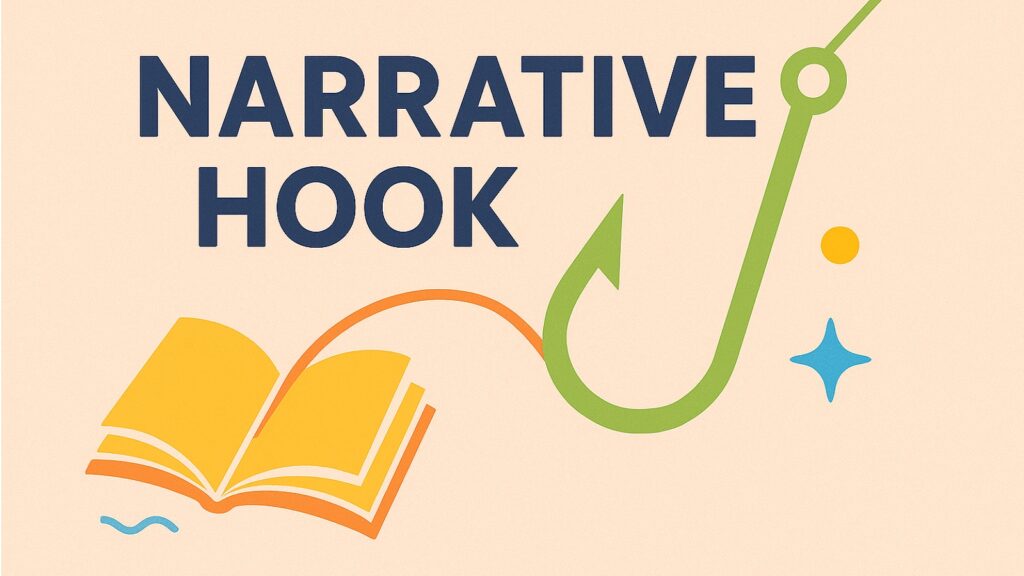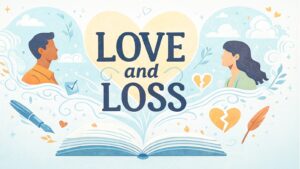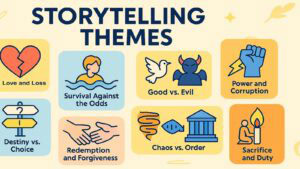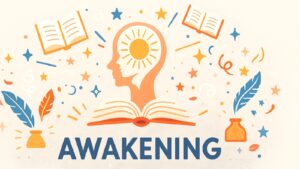Table of Contents
Introduction: Narrative Hook as a Storytelling Psychology
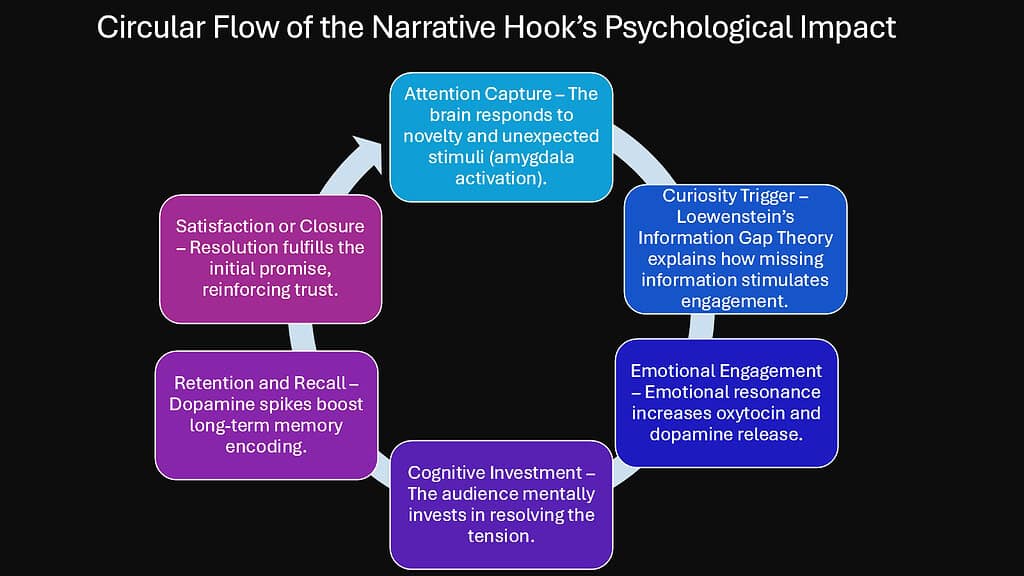
Picture this moment: You’re scrolling through countless stories online when suddenly one opening line stops you cold. Your finger freezes over the screen. Your mind demands to know what happens next. That invisible force pulling you forward represents one of storytelling’s most powerful psychological tools—the narrative hook.
The narrative hook operates as the gateway between indifference and obsession. It transforms casual browsers into devoted readers within seconds. This psychological mechanism taps directly into fundamental human drives that have kept our species alive for millennia. When crafted skillfully, it becomes an irresistible mental magnet.
Understanding narrative hooks means recognizing them as sophisticated brain hacks. They exploit cognitive patterns that evolution carved into our neural pathways. Unlike simple attention-grabbing techniques, narrative hooks create sustained psychological engagement. They not only attract attention—they also seize the imagination and do not release it.
The narrative hook stands among storytelling’s most crucial psychological frameworks, sharing space with other powerful techniques like emotional arcs and suspense building. However, while emotional arcs develop over time and suspense builds gradually, the narrative hook strikes immediately. It differs from the mirror effect, which relies on reader identification, and world immersion, which creates atmospheric depth. The hook operates faster than moral framing and more directly than twist-and-reframe strategies.
This exploration reveals six specific brain hacks that transform ordinary openings into magnetic narrative hooks. Each technique targets different cognitive systems, from curiosity circuits to pattern recognition networks. These methods work across all storytelling mediums—novels, films, articles, and presentations alike.
The following sections dissect exactly how masterful storytellers manipulate these psychological triggers. You’ll discover the neurological reasons why certain openings feel impossible to ignore while others fade instantly from memory.
| Storytelling Psychologies | Primary Function | Activation Speed | Reader Impact |
|---|---|---|---|
| Narrative Hook | Immediate capture | Instantaneous | Compels continuation |
| Emotional Arc | Sustained engagement | Gradual build | Creates investment |
| Suspense | Tension maintenance | Progressive | Maintains attention |
| Mirror Effect | Reader identification | Variable | Personal connection |
| World Immersion | Atmospheric depth | Slow development | Environmental draw |
| Twist and Reframe | Perspective shift | Strategic timing | Cognitive surprise |
1. Narrative Hook and the Curiosity Gap Effect
The human brain harbors an insatiable hunger for complete information. When George Loewenstein developed his Information Gap Theory, he revealed why partial knowledge creates such psychological discomfort. This discomfort drives the curiosity gap effect, transforming narrative hooks into irresistible mental compulsions.
Loewenstein discovered that knowing something exists but lacking complete understanding triggers intense motivation. The mind experiences this gap as actual pain. The reward system of the brain is triggered, inundating awareness with chemicals that induce anticipation. This neurological response explains why effective narrative hooks feel almost addictive.
Consider how Dan Brown opens “The Da Vinci Code” with Robert Langdon receiving a mysterious midnight call from the French police. Readers immediately know something significant happened, but the crucial details remain hidden. This gap between knowing and understanding creates psychological tension that demands resolution.
The curiosity gap operates through strategic information withholding. Skillful writers reveal just enough to establish stakes while concealing the mechanisms behind those stakes. They provide context without explanation, creating mental itch that only continued reading can scratch. This technique transforms passive readers into active investigators.
Master practitioners understand that curiosity gaps must feel earned rather than manipulated. The withheld information should relate directly to something readers care about. Random mysteries generate mild interest, but mysteries threatening beloved characters or challenging fundamental assumptions create genuine obsession.
The gap must also promise satisfying resolution. Readers subconsciously evaluate whether pursuing the mystery will reward their invested attention. Vague, overwhelming, or seemingly unsolvable puzzles often backfire, creating frustration instead of engagement. The most effective gaps hint at their own solutions.
Contemporary digital content significantly gains from the implementation of curiosity gap strategies. Social media headlines that promise surprising revelations while withholding key details exploit this same psychological mechanism. Email subject lines that begin with intriguing partial statements create similar effects.
| Information Gap Elements | Psychological Effect | Reader Response | Application Method |
|---|---|---|---|
| Partial revelation | Mental tension | Seeks completion | Strategic withholding |
| Missing context | Cognitive discomfort | Active investigation | Contextual hints |
| Implied consequences | Emotional investment | Continuation drive | Stakes establishment |
| Hidden mechanisms | Curiosity activation | Question formation | Mystery layering |
| Resolution promise | Engagement sustenance | Sustained attention | Payoff indicators |
| Personal relevance | Psychological ownership | Deep involvement | Character connection |
2. Narrative Hook Through Emotional Contrast
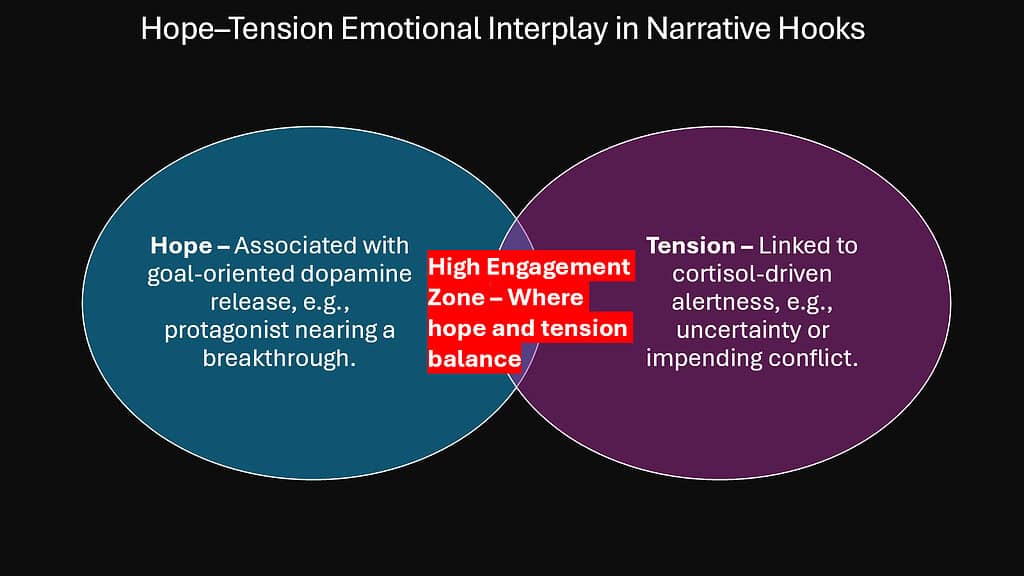
The human emotional system operates through contrast and comparison. When conflicting emotions collide within a single narrative moment, they create psychological friction that demands resolution. This emotional contrast serves as one of the most powerful narrative hook mechanisms available to storytellers.
Emotional contrast works by activating multiple feeling centers simultaneously. The brain struggles to process contradictory emotional signals, creating internal tension that translates into reader engagement. This technique differs from simple emotional appeals because it generates complexity rather than single-note responses.
Consider the opening of Khaled Hosseini’s “The Kite Runner,” where adult Amir reflects on a childhood betrayal while walking through peaceful San Francisco. The tranquil present moment contrasts sharply with the haunting memories of Afghanistan. Readers experience both serenity and guilt simultaneously, creating an emotional puzzle that hooks attention.
Effective emotional contrast frequently intertwines hope with fear, love with loss, or triumph with tragedy. These opposing forces create internal conflict that mirrors real human experience. Readers recognize this emotional complexity as authentic, drawing them deeper into the narrative world.
The technique works particularly well when contrasting emotions relate to the same situation or character. A mother’s joy at her child’s wedding coupled with grief over her deceased spouse’s absence creates more powerful hooks than unrelated emotional shifts. The connection between contrasting feelings amplifies their impact.
Writers achieve emotional contrast through careful word choice, imagery selection, and situational framing. A single sentence can contain both celebration and sorrow, excitement and dread, anticipation and regret. The key lies in making these contrasts feel natural rather than forced.
Visual storytelling mediums like film and graphic narratives excel at emotional contrast through simultaneous presentation of conflicting elements. A character might smile while tears fall, or beautiful scenery might frame terrible events. These visual contradictions create immediate emotional hooks.
| Emotional Contrast Pairs | Psychological Tension | Reader Engagement | Narrative Function |
|---|---|---|---|
| Hope and Fear | Anticipation anxiety | Sustained attention | Uncertainty creation |
| Love and Loss | Bittersweet longing | Emotional investment | Connection deepening |
| Joy and Guilt | Internal conflict | Self-reflection | Character complexity |
| Triumph and Sacrifice | Achievement cost | Value questioning | Theme exploration |
| Peace and Memory | Temporal displacement | Curiosity generation | Background mystery |
| Pride and Shame | Identity tension | Judgment suspension | Moral complexity |
3. Narrative Hook and the In Medias Res Technique
Starting stories in the middle of action, known as in medias res, represents one of literature’s oldest and most effective hooking strategies. This technique drops readers directly into ongoing situations, bypassing lengthy setup while creating immediate engagement. The brain, suddenly thrust into unfamiliar circumstances, desperately seeks context and understanding.
In medias res functions by taking advantage of the human desire for situational awareness. When confronted with partial scenarios, the mind automatically begins constructing explanatory frameworks. This cognitive process creates active rather than passive reading, transforming audiences into collaborative storytellers who must piece together missing information.
Homer pioneered this technique in “The Odyssey,” beginning with Odysseus already trapped on Calypso’s island rather than starting with the Trojan War. Modern masters like Elmore Leonard frequently open novels mid-conversation or mid-conflict, forcing readers to catch up with ongoing action. This disorientation becomes a feature rather than a bug.
The technique succeeds because it mimics how we actually encounter real situations. Life rarely provides comprehensive background information before events unfold. We meet people mid-conversation, witness accidents in progress, and discover ongoing dramas without exposition. In medias res hooks tap into this familiar experience.
Effective in medias res openings contain enough context clues for readers to orient themselves while maintaining enough mystery to drive continued engagement. The key lies in balancing confusion with comprehension. Too little information frustrates readers, while too much eliminates the hook’s power.
Action scenes work particularly well for in medias res openings because they inherently contain forward momentum. Chase sequences, arguments, emergencies, and confrontations all provide natural energy that pulls readers along. The combination of immediate action and mysterious context creates irresistible narrative propulsion.
Digital storytelling increasingly relies on in medias res techniques. Social media posts that reference ongoing situations without full explanation, video content that begins mid-action, and interactive narratives that drop users into existing scenarios all benefit from this psychological mechanism.
| In Medias Res Elements | Cognitive Response | Engagement Result | Storytelling Benefit |
|---|---|---|---|
| Immediate action | Attention capture | Instant involvement | Energy establishment |
| Missing context | Active construction | Reader participation | Cognitive investment |
| Partial information | Pattern seeking | Detective behavior | Sustained curiosity |
| Ongoing situations | Reality mimicking | Authenticity feeling | Natural immersion |
| Momentum presence | Forward propulsion | Continuation drive | Pacing advantage |
| Mystery maintenance | Question generation | Answer seeking | Long-term engagement |
4. Narrative Hook Using Pattern Disruption
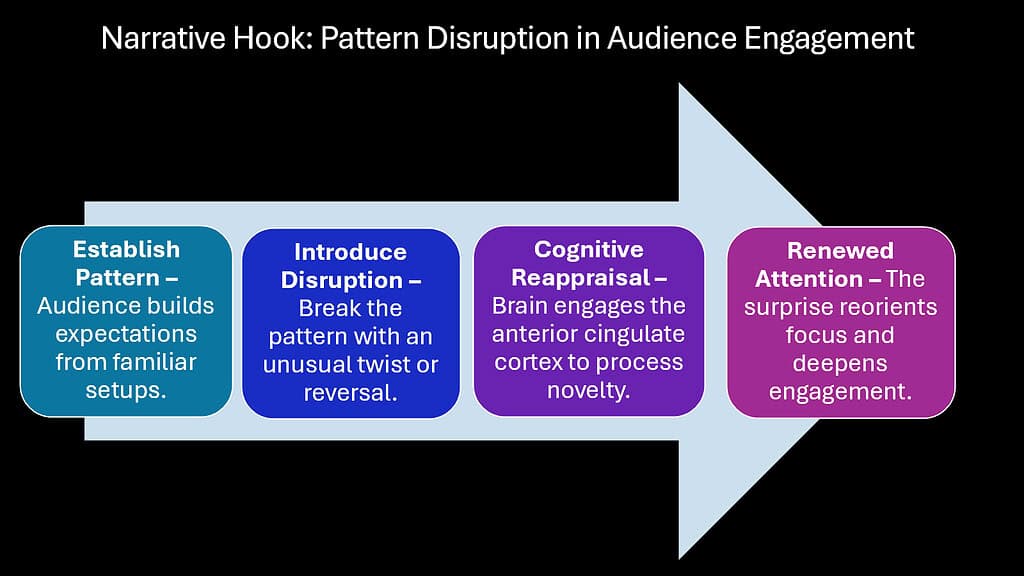
The human brain operates as a sophisticated pattern recognition system, constantly seeking familiar structures and predictable sequences. When narratives deliberately break these expected patterns, they trigger intense cognitive responses. This pattern disruption creates narrative hooks by forcing the mind to recalibrate its understanding of unfolding events.
Pattern disruption works because our brains conserve energy by relying on established templates. When familiar patterns suddenly shift, the mind must abandon automatic processing and engage conscious attention. This shift from passive to active mental engagement transforms casual readers into invested participants.
Consider how Gillian Flynn opens “Gone Girl” with what appears to be a typical missing person story, then gradually reveals information that violates every expectation about victimhood, marriage, and truth. Every revelation interrupts established patterns, resulting in compulsive reading as audiences endeavor to sustain a coherent understanding.
Effective pattern disruption requires establishing patterns before breaking them. Writers must first create recognizable situations, character types, or narrative structures. Only after readers settle into comfortable assumptions can the disruption achieve maximum impact. The disparity between what is anticipated and what actually occurs creates a psychological engagement.
The technique works across multiple levels simultaneously. Surface patterns might involve genre conventions, while deeper patterns concern character behavior, moral frameworks, or cause-and-effect relationships. Skilled writers layer multiple disruptions, creating cascading effects that maintain engagement throughout entire narratives.
Genre conventions provide particularly fertile ground for pattern disruption. Romance novels that subvert relationship expectations, mysteries that challenge detection methods, or horror stories that reframe traditional monsters all benefit from this technique. The familiarity of genre patterns makes their disruption especially powerful.
Modern audiences, saturated with similar content, particularly respond to pattern disruption. Social media algorithms favor unexpected content, while streaming platforms promote shows that defy categorization. Pattern disruption serves as an antidote to content homogenization, offering audiences genuinely surprising experiences.
| Pattern Types | Disruption Methods | Cognitive Effect | Engagement Outcome |
|---|---|---|---|
| Genre conventions | Expectation violation | Mental recalibration | Increased attention |
| Character archetypes | Behavioral contradiction | Assumption challenge | Deeper analysis |
| Narrative structure | Sequence alteration | Processing disruption | Active involvement |
| Moral frameworks | Ethical ambiguity | Value questioning | Sustained reflection |
| Cause-effect chains | Logic subversion | Understanding crisis | Persistent curiosity |
| Familiar situations | Context shifting | Reality questioning | Heightened awareness |
5. Narrative Hook and the Hero’s Quest Pulse
Joseph Campbell’s Hero’s Quest framework maps the psychological stages of transformative human experience. While the complete journey spans entire narratives, its opening phase—the Call to Adventure—contains concentrated hooking power. This stage creates narrative hooks by tapping into fundamental human drives toward growth, challenge, and meaning.
The Call to Adventure works as a narrative hook because it promises transformation. Human psychology gravitates toward change stories, particularly those involving ordinary individuals facing extraordinary circumstances. This pattern resonates with deep-seated desires for personal growth and significance that most people carry throughout their lives.
Campbell identified the Call to Adventure as the moment when familiar life circumstances shift dramatically. Luke Skywalker discovering Princess Leia’s message, Harry Potter receiving his Hogwarts letter, or Neo encountering Morpheus all represent this pivotal moment. Each example transforms mundane existence into meaningful quest narrative.
Effective Hero’s Journey hooks establish ordinary worlds before introducing extraordinary calls. The contrast between familiar circumstances and impossible opportunities creates psychological tension. Readers experience simultaneous comfort with the ordinary and excitement about the extraordinary, generating emotional investment in the character’s choice.
The Call to Adventure often involves external messengers—letters, strangers, discoveries, or emergencies that intrude upon normal life. These external triggers represent forces beyond the protagonist’s control, suggesting that transformation stems from destiny rather than arbitrary choice. This inevitability adds weight to the narrative hook.
Modern storytelling frequently compresses the Hero’s Journey opening, combining ordinary world establishment with adventure calling in single scenes or sequences. Television pilots, film openings, and novel first chapters must accomplish both tasks efficiently while maintaining hooking power throughout the compressed presentation.
Digital content creators increasingly apply Hero’s Journey principles to non-fiction narratives. Personal development content, business success stories, and educational materials all benefit from framing information as transformative journeys. The psychological appeal of the Call to Adventure extends beyond fiction into practical applications.
| Hero’s Journey Stages | Psychological Appeal | Hook Function | Modern Application |
|---|---|---|---|
| Ordinary World | Relatability establishment | Comfort creation | Audience connection |
| Call to Adventure | Transformation promise | Excitement generation | Change motivation |
| Refusal of Call | Human hesitation | Authenticity building | Realistic portrayal |
| Meeting Mentor | Guidance provision | Support indication | Learning framework |
| Crossing Threshold | Commitment moment | Stakes elevation | Investment point |
| Tests and Allies | Challenge presentation | Engagement sustenance | Skill development |
6. Narrative Hook Through Sensory Immersion
The human brain processes sensory information through multiple specialized pathways that directly influence emotional and memory systems. Narrative hooks that engage these sensory channels create immediate, visceral connections between readers and story worlds. This sensory immersion bypasses rational analysis, creating subconscious engagement that feels both immediate and authentic.
Sensory details work as narrative hooks because they activate the same neural pathways involved in actual experience. When readers encounter vivid descriptions of sounds, smells, textures, or visual elements, their brains respond similarly to real sensory input. This neurological mimicry creates psychological presence within narrative spaces.
Consider how Proust opens “Swann’s Way” with the narrator’s detailed description of madeleine cake dipped in tea. The scent of rain on warm pavement, the noise of ice breaking beneath footsteps, or the feel of aged leather can create complete atmospheric settings with little verbal effort.
Effective sensory hooks often focus on unexpected or particularly evocative details rather than comprehensive descriptions. The smell of rain on hot pavement, the sound of ice cracking under footsteps, or the texture of worn leather can establish entire atmospheric frameworks with minimal word investment.
Different sensory channels carry distinct emotional associations. Visual details often establish setting and mood, while auditory elements create tension or comfort. Tactile descriptions foster intimacy and physical reality, taste and smell trigger memory and desire. Strategic sensory selection shapes reader emotional responses.
The technique proves particularly valuable for establishing genre expectations and emotional tones. Horror narratives benefit from unsettling sensory details, romance from intimate or beautiful ones, adventure from dynamic or exotic sensations. Sensory choices communicate genre promises before plot developments confirm them.
Digital storytelling increasingly incorporates multisensory elements through audio, video, and interactive components. Virtual reality experiences represent the ultimate extension of sensory immersion, while simpler digital content uses sound effects, visual design, and interactive elements to engage multiple sensory channels simultaneously.
| Sensory Channels | Emotional Association | Memory Connection | Effectiveness Of Narrative Hook |
|---|---|---|---|
| Visual details | Mood establishment | Scene recognition | High immediate impact |
| Auditory elements | Tension creation | Musical memory | Strong atmosphere building |
| Tactile descriptions | Intimacy fostering | Physical memory | Deep personal connection |
| Olfactory references | Emotion triggering | Involuntary recall | Powerful subconscious response |
| Gustatory details | Comfort or desire | Cultural memory | Specific cultural connection |
| Temperature sensations | Physical presence | Environmental memory | Realistic immersion |
Conclusion: Narrative Hook as the Key to Lasting Impact
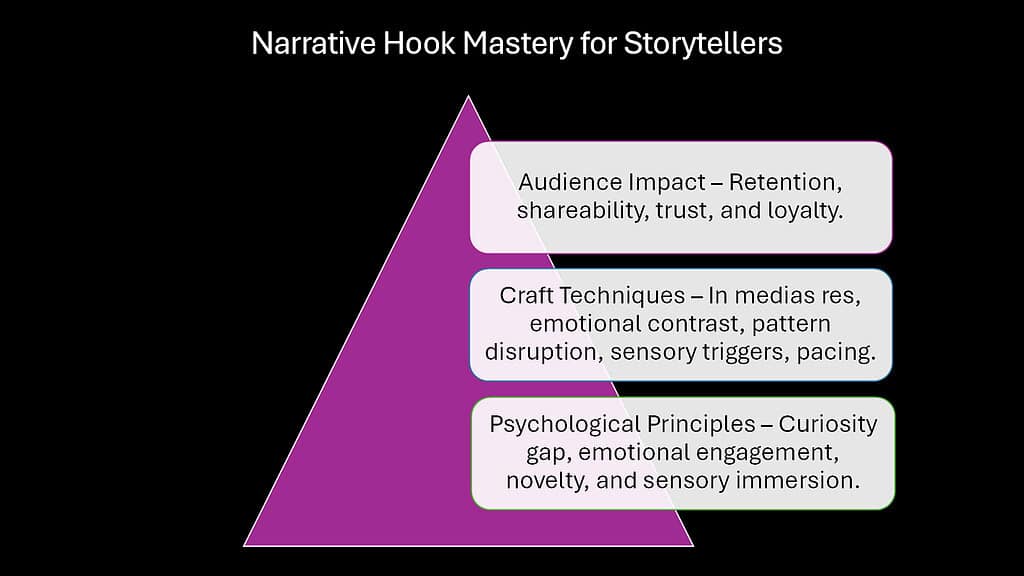
The six brain hacks explored throughout this analysis reveal narrative hooks as sophisticated psychological instruments rather than simple attention-grabbing devices. Each technique—curiosity gaps, emotional contrast, in medias res openings, pattern disruption, Hero’s Journey calls, and sensory immersion—targets specific cognitive systems that evolution designed to ensure human survival and growth.
These mechanisms work because they exploit fundamental aspects of human psychology. Our brains seek complete information, crave emotional coherence, demand situational awareness, recognize patterns, pursue transformation, and process sensory reality. Narrative hooks that engage these systems create engagement that feels both natural and irresistible.
The effectiveness of these methods reaches well beyond mere entertainment value. Educational content that employs narrative hooks improves retention and comprehension. Business communications using these methods increase audience engagement and message effectiveness. Personal storytelling enhanced by these principles creates deeper connections and more memorable experiences.
Understanding narrative hooks as psychological tools rather than creative mysteries democratizes their application. Writers no longer need to rely on intuition or inspiration alone. These six brain hacks provide systematic approaches to creating opening moments that capture and sustain audience attention across any medium or purpose.
The digital age has intensified the importance of effective narrative hooks. Shorter attention spans, infinite content choices, and constant distractions make the opening moments of any narrative more crucial than ever. Content that fails to hook audiences immediately often fails entirely, regardless of its eventual quality or value.
Future storytelling will likely develop even more sophisticated hooking techniques as neuroscience reveals additional insights into human attention and engagement systems. Virtual and augmented reality technologies will enable multisensory hooks impossible in traditional media. However, the fundamental psychological principles underlying these six brain hacks will remain constant.
The mastery of narrative hooks represents an investment in human connection. Every story that successfully captures attention creates a moment of shared consciousness between storyteller and audience. In an increasingly fragmented world, these moments of connection carry value beyond their immediate entertainment or informational purpose.
| Brain Hack Categories | Primary Targets | Application Areas | Long-term Benefits |
|---|---|---|---|
| Cognitive gaps | Information systems | Education, journalism | Knowledge retention |
| Emotional contrasts | Feeling centers | Marketing, relationships | Emotional intelligence |
| Action immersion | Attention mechanisms | Entertainment, training | Engagement skills |
| Pattern breaks | Recognition systems | Innovation, creativity | Flexible thinking |
| Journey calls | Transformation drives | Personal development | Growth motivation |
| Sensory details | Experience pathways | Memory, communication | Rich recall ability |

